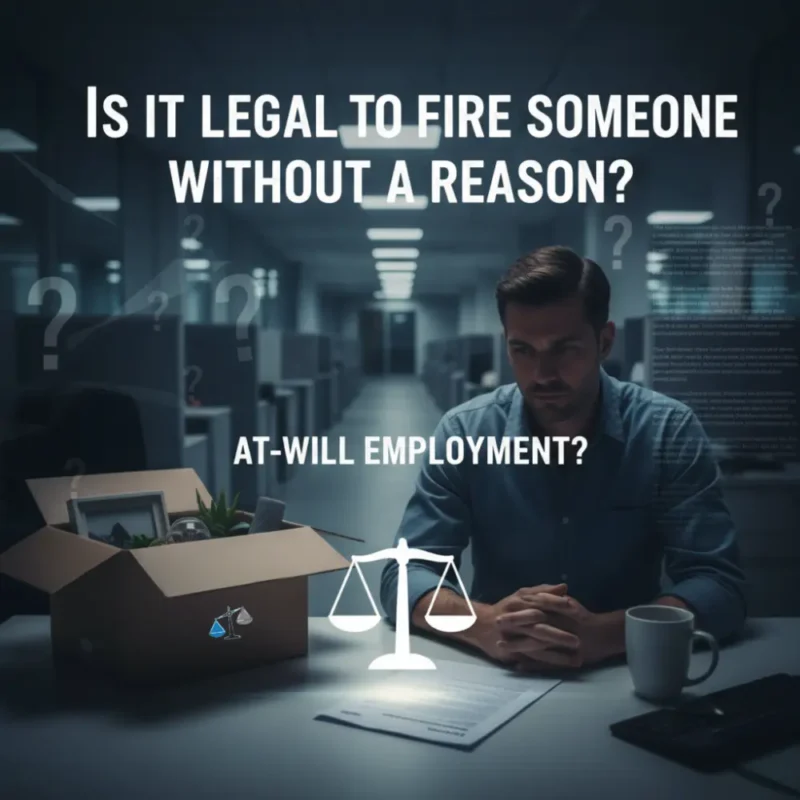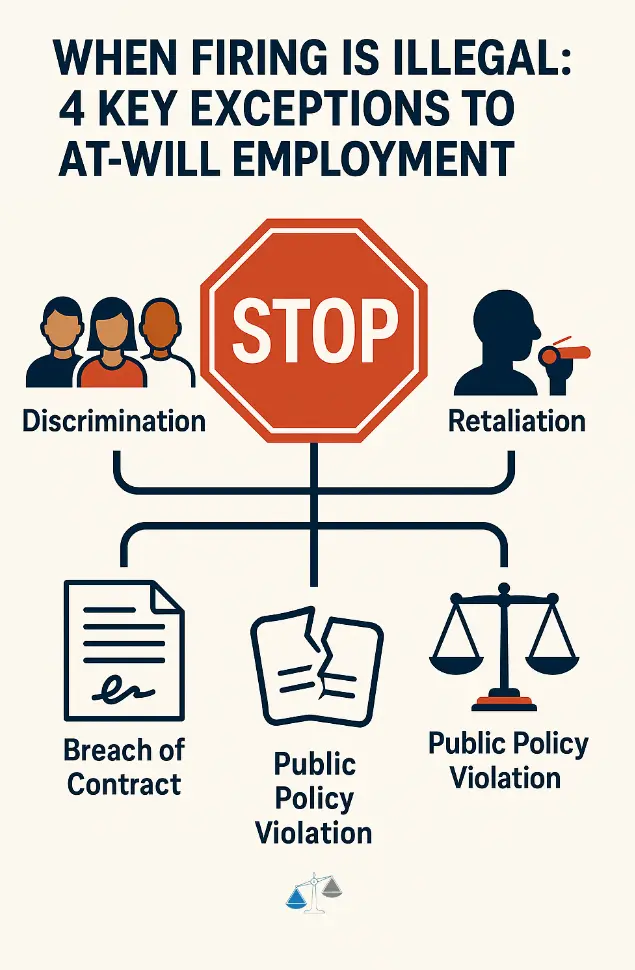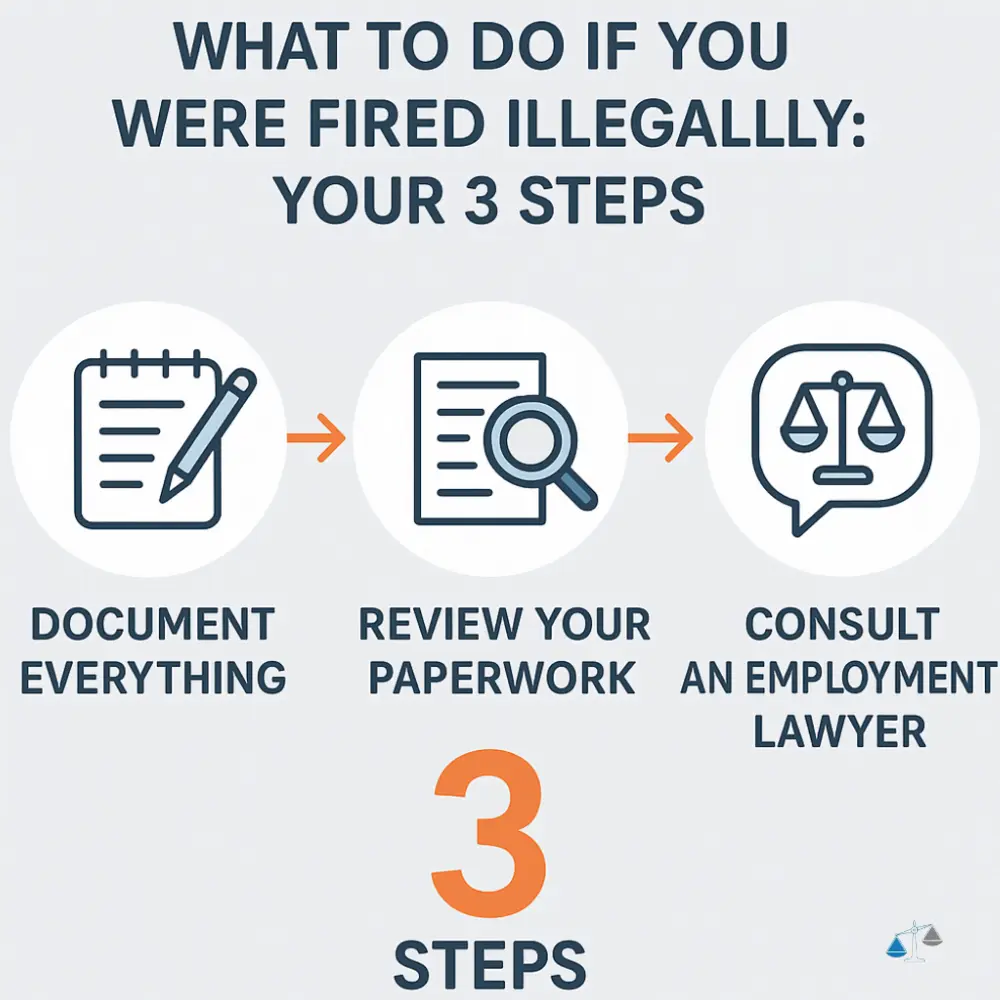Is It Legal to Fire Someone Without a Reason?

- Is It Legal to Fire Someone Without a Reason?
- The Core Principle: Understanding "At-Will" Employment
- What Does "At-Will" Actually Mean?
- A Two-Way Street: The Employee's Right to Quit
- Which States Are At-Will? (A Quick Overview)
- So, You Can Be Fired for Any Reason? Not Exactly.
- The Big Exceptions: When "No Reason" Becomes Wrongful Termination
- Discrimination: Firing Based on Who You Are
- Retaliation: Firing as a Punishment
- Breach of Contract: When a Promise is Broken
- Written vs. Implied Contracts
- Public Policy Violations: Firing for Doing the Right Thing
- "Fired Without Cause": What Happens to Your Benefits?
- What "Without Cause" Means for Unemployment
- Severance Pay: Is It Required?
- Your Final Paycheck
- What to Do If You Suspect You Were Fired Illegally
- Step 1: Document Everything
- Step 2: Review Your Employment Documents
- Step 3: Consider a Consultation with an Employment Lawyer
- Frequently Asked Questions (FAQ)
- Can I be fired without any prior warning?
- Is "not being a good fit" a legal reason to fire someone?
- What's the difference between being laid off and being fired?
- Do I have to sign a severance agreement?
- Can I be fired for something I posted on social media?
- What is "constructive dismissal"?
- How do I prove I was fired for an illegal reason if my boss gave no reason?
- Can I get unemployment if my employer claims I quit, but I was actually fired?
- How long do I have to file a wrongful termination claim?
- I live in Montana. Does that mean I can't be fired?
- Conclusion: Know Your Rights
The meeting was short. Your boss looked uncomfortable, used vague phrases like “restructuring,” “not a good fit,” or “going in a different direction,” and before you knew it, you were packing your desk. You rack your brain, trying to figure out what you did wrong. Was it that project last week? A comment you made in a meeting? Often, the answer is nothing. This leaves you with a sinking feeling and one burning question: Can they really do that? Can they fire me for no reason at all?
For most employees in the United States, the short, and often surprising, answer is: yes.
This isn’t a loophole or a gray area; it’s a foundational legal doctrine of American labor law known as “at-will employment.” The concept can feel unfair, and in many ways, it’s a harsh reality of the modern workplace. However, it’s not a free pass for employers to fire people for any reason they can dream up. The “at-will” rule has critical exceptions that protect employees from being fired for illegal reasons.
In this article, we’ll break down exactly what at-will employment means, explore the crucial exceptions that define wrongful termination, and outline what you can do if you believe your firing wasn’t just without reason, but for an illegal one.
The Core Principle: Understanding “At-Will” Employment
The term “at-will” is the legal foundation for the employer-employee relationship in nearly every state. While it sounds like complex legal jargon, its core idea is surprisingly straightforward.
What Does “At-Will” Actually Mean?
In its simplest form, at-will employment means that an employer can terminate an employee’s job at any time, for any reason, or for no reason at all—as long as the reason is not illegal. There is no requirement for the employer to provide a warning, a “good cause,” or an explanation.
They can fire you because they don’t like your favorite sports team, because they think you’re too quiet, or simply because they woke up on the wrong side of the bed. As shocking as these reasons sound, under the at-will doctrine, they are perfectly legal grounds for dismissal. The key here is that the reason, however arbitrary or unfair it may seem, cannot be an illegal one (we’ll dive deep into that in the next section).
A Two-Way Street: The Employee’s Right to Quit
It’s important to remember that at-will employment works both ways. Just as an employer can fire you without a reason, you, the employee, can quit your job at any time, for any reason, without providing a reason. You can leave because you found a better opportunity, because you want to travel the world, or just because you don’t feel like working there anymore.
While giving a two-week notice is a professional courtesy and highly recommended to maintain good relationships, it’s generally not a legal requirement under the at-will doctrine. This mutual freedom is the central pillar of the “at-will” principle.
Which States Are At-Will? (A Quick Overview)
This is where it gets interesting. The principle of at-will employment is the default rule in 49 out of the 50 U.S. states.
The sole exception is Montana. Montana has a “good cause” standard, meaning that after a probationary period, an employer cannot fire an employee without a legitimate business-related reason, such as misconduct or poor performance. For the rest of the country, unless you have a specific contract stating otherwise, you are presumed to be an at-will employee.
So, You Can Be Fired for Any Reason? Not Exactly.
At this point, you might be thinking that the at-will doctrine gives employers absolute power. It’s true that they can fire you for reasons that are trivial, unfair, or just plain senseless. But there’s a huge and critically important line they cannot cross.
This is where we must distinguish between an unfair firing and an illegal firing.
- An unfair firing might be your boss letting you go because you don’t laugh at their jokes or because they prefer to hire their nephew. It feels wrong and it’s bad management, but in most cases, it’s perfectly legal.
- An illegal firing, on the other hand, is when the “no reason” given is actually a cover-up for a reason that violates federal, state, or local laws.
The at-will doctrine does not protect an employer who fires someone for a discriminatory reason, as retaliation for a protected activity, or in violation of an employment contract. The law essentially says, “You can fire someone without a good reason, but you absolutely cannot fire them for a bad reason that we have specifically outlawed.”
Think of it this way: at-will employment is the general rule, but it is overridden by a powerful set of exceptions designed to protect fundamental employee rights. Now, let’s explore exactly what those exceptions are.
The Big Exceptions: When “No Reason” Becomes Wrongful Termination
While the “at-will” rule provides broad discretion, it is not a shield for employers to act unlawfully. Federal and state laws have carved out significant exceptions to protect employees from being fired for reasons that society deems unacceptable. If your termination falls into one of these categories, you may have a case for wrongful termination.

Discrimination: Firing Based on Who You Are
This is perhaps the most well-known exception to at-will employment. Federal and state laws make it illegal for an employer to fire you based on your membership in a “protected class.” These are personal characteristics that cannot be used as a basis for employment decisions.
Key federally protected classes include:
- Race or Color: Firing someone because of their skin color or racial background.
- National Origin: Terminating an employee based on their country of origin, ancestry, or accent.
- Religion: Firing someone for their religious beliefs or practices (or lack thereof).
- Sex: This includes gender, gender identity, sexual orientation, and pregnancy status. For example, firing a woman shortly after she announces she is pregnant is a classic case of sex discrimination.
- Age: Specifically, this protects individuals who are 40 years of age or older from being replaced by younger workers simply because of their age.
- Disability: Firing an employee due to a physical or mental disability, especially when they are capable of performing the essential functions of the job with reasonable accommodation.
- Genetic Information: Firing someone based on genetic test results or family medical history.
Example in Plain English: Imagine a 55-year-old employee with a great performance record is suddenly fired. The company gives a vague reason like “we’re updating our team’s skill set.” A week later, they hire a 28-year-old for the same position. If the older employee can show a pattern of the company pushing out older workers, this “no reason” firing could easily be seen as a pretext for illegal age discrimination.
| Exception Type | Fired For… | Plain English Example |
|---|---|---|
| Discrimination | Being part of a protected class (e.g., age, race, gender, religion, disability). | Firing someone shortly after they turn 60 and replacing them with a younger, less experienced employee for the same role. |
| Retaliation | Exercising a legally protected right (e.g., reporting harassment, whistleblowing). | Terminating an employee a week after they filed a formal complaint about unsafe working conditions. |
| Breach of Contract | Violating the terms of an existing employment agreement. | Dismissing an employee immediately when the company’s official handbook specifies a mandatory three-step progressive discipline process for performance issues. |
| Public Policy | Refusing to perform an illegal act or fulfilling a civic duty (e.g., jury duty). | Firing a truck driver for refusing to violate legally mandated driving-hour limits, which could endanger public safety. |
It’s important to note that many states and cities have their own anti-discrimination laws that may offer even broader protections, such as for marital status or political affiliation.
Retaliation: Firing as a Punishment
The law recognizes that if employees fear being fired for speaking up, then workplace protections for discrimination, safety, and fairness would be meaningless. That’s why there are strong laws against retaliation.
In simple terms, retaliation means an employer punishes an employee (by firing, demoting, or harassing them) for engaging in a legally protected activity. Essentially, they are firing you for doing something you have the legal right to do. You can’t be fired for being a “troublemaker” when the trouble you’re making is asserting your rights.
Common examples of legally protected activities include:
- Reporting Harassment or Discrimination: Filing a formal complaint with HR or an external agency (like the EEOC) about discrimination or harassment directed at you or a colleague.
- Whistleblowing: Reporting illegal activities by your employer, such as financial fraud, environmental violations, or unsafe working conditions to a government agency.
- Filing a Workers’ Compensation Claim: Seeking benefits after being injured on the job. An employer cannot fire you for costing them money by filing a legitimate claim.
- Requesting Accommodation: Asking for a reasonable accommodation for a disability or a religious practice (e.g., a modified workstation or a flexible schedule for religious observance).
- Participating in an Investigation: Serving as a witness in a lawsuit or investigation against the company.
- Discussing Wages: Talking about your salary and pay rates with coworkers, a right protected under the National Labor Relations Act to ensure fair pay.
Example in Plain English: Let’s say you notice and report a serious safety violation at your workplace. Your manager thanks you, but his attitude towards you changes. Two weeks later, you’re fired for being “late” by five minutes, even though other employees are frequently later with no consequences. This timing is highly suspicious. It’s likely that the “lateness” was a pretext—a made-up reason—to hide the real, illegal reason: retaliating against you for reporting the safety violation.
Breach of Contract: When a Promise is Broken
The “at-will” doctrine is the default rule, but it can be overridden by a contract. If you have an employment contract that outlines the terms of your dismissal, your employer must follow it. Firing you in a way that violates this agreement is illegal, known as a “breach of contract.”
These contracts can come in two forms: written and implied.
Written vs. Implied Contracts
- Written Contracts: This is the most straightforward type. If you signed a document that specifies a fixed term of employment (e.g., “a one-year contract”) or states that you can only be fired “for cause” (listing specific reasons like gross misconduct or consistent poor performance), then you are not an at-will employee. Your employer cannot fire you for “no reason” without breaching the contract. These are common for executive, creative, or highly specialized roles.
- Implied Contracts: This is a more complex but equally important concept. An implied contract is an unwritten agreement that is created through the employer’s words, actions, or official documents. While harder to prove, courts in some states have recognized them. Examples include:
- Verbal Promises: A manager assuring you during the hiring process, “As long as you meet your sales quotas, you’ll always have a job here.”
- Company Handbooks & Policies: An employee handbook that outlines a specific disciplinary process (e.g., a verbal warning, then a written warning, then termination) can sometimes be interpreted as an implied promise that the company will follow those steps. However, be aware: Many companies now include a disclaimer in their handbooks stating that it is not a contract and that employment remains at-will.
Example in Plain English: Imagine your company handbook has a detailed “progressive discipline” policy. It says that for performance issues, an employee will first receive coaching, then a formal warning, and only then face termination. If you are a long-time employee with a good record and you’re suddenly fired for a single, minor mistake without any of those steps being followed, you might have a case for breach of an implied contract. The company didn’t follow its own promised procedure.
Public Policy Violations: Firing for Doing the Right Thing
This is a broad but powerful exception to at-will employment. The public policy exception essentially states that an employer cannot fire you for a reason that violates a fundamental principle of public well-being. Society wants to encourage people to do the right thing, and this legal doctrine supports that.
While it can vary by state, firings that violate public policy generally fall into four categories:
- Refusing to Perform an Illegal Act: Your boss orders you to lie on a financial report, dump hazardous waste illegally, or engage in any activity that breaks the law. You refuse, and you are fired. This is wrongful termination.
- Exercising a Statutory Right: You are fired for exercising a legal right granted to you by law, such as filing a legitimate workers’ compensation claim after an injury or taking leave under the Family and Medical Leave Act (FMLA).
- Fulfilling a Civic Duty: Your employer cannot fire you for performing a civic duty that requires you to miss work, such as jury duty or voting.
- Reporting Illegal Activity: Also known as whistleblowing, you report your company’s illegal actions to the authorities, and you are fired as a result.
Example in Plain English: Imagine you work for a trucking company. Your manager tells you to make a delivery that would require you to drive for 14 straight hours, a clear violation of federal safety regulations designed to prevent tired drivers from causing accidents. You refuse, citing the law and safety concerns. The next day, you are fired for “insubordination.” This is a classic case of a public policy violation. You were fired for refusing to break the law, and that’s a protected action.
“Fired Without Cause”: What Happens to Your Benefits?
Even if your firing was perfectly legal under the at-will doctrine, the way your employment ends still matters. The reason for your termination—or lack thereof—directly impacts your eligibility for certain benefits. The term “fired without cause” is key here. It generally means you were let go for reasons that were not your fault, such as a layoff, restructuring, or simply not being the right fit for the role.
This is different from being fired “for cause,” which implies you were terminated due to serious misconduct (like stealing, harassment, or insubordination).
What “Without Cause” Means for Unemployment
This is the most important takeaway: If you are fired “without cause,” you are generally eligible for unemployment benefits.
Unemployment insurance is a state-run program designed to provide a financial safety net for people who lose their jobs through no fault of their own.
- You’re Likely Eligible If: You were laid off, your position was eliminated, or you were fired because your performance wasn’t meeting expectations (but not due to willful misconduct). Being fired for “no reason” almost always falls into this category.
- You’re Likely Ineligible If: You were fired “for cause” due to serious misconduct. For example, you were caught stealing, you failed a drug test, or you repeatedly violated a major company policy.
Pro Tip: Always apply for unemployment benefits, regardless of what your former employer tells you. Let the state unemployment agency make the final determination about your eligibility.
Severance Pay: Is It Required?
This often comes as a surprise to many, but under federal law, employers are generally not required to offer severance pay.
Severance is a benefit offered at the employer’s discretion. It is most commonly seen in two situations:
- As a Company Policy: It’s part of the company’s standard procedure for certain types of separations, like layoffs.
- In Exchange for a Release: An employer might offer you a severance package in exchange for you signing a separation agreement. This document typically includes a clause where you agree not to sue the company for any reason related to your employment or termination.
Before signing any separation agreement, it’s highly advisable to have it reviewed by an employment lawyer, as you may be signing away important rights.
Your Final Paycheck
One thing that is not optional is your final pay. Employers are legally required to pay you for all the time you’ve worked. The rules on when you must receive this final paycheck vary significantly by state. Some states require it to be given to you on your last day of work, while others allow the employer to wait until the next scheduled payday. Check your state’s Department of Labor website to understand the specific rules for your location.
What to Do If You Suspect You Were Fired Illegally

Feeling that you’ve been fired unfairly is one thing; proving it was illegal is another. If your gut tells you that the “no reason” you were given was just a convenient excuse for a discriminatory or retaliatory motive, it’s crucial to act methodically, not just emotionally. Here are the steps you should consider taking.
Step 1: Document Everything
Your memory is your most critical piece of evidence, but it can fade and be questioned. Immediately after being fired, sit down and write down everything you can remember.
- Create a Timeline: Detail the events leading up to your termination. Did you recently report harassment? File for medical leave? Receive a positive performance review just before being let go? Write it all down with dates.
- Record the Termination Meeting: Who was there? What exactly was said by each person? What reason, if any, were you given? Were there any strange or out-of-place comments?
- Gather Your Records: Collect all your employment-related documents that you have access to. This includes performance reviews (especially positive ones), emails, memos, letters of commendation, and any correspondence that could support your case. For example, an email from your boss praising your work a week before you were fired for “poor performance” would be very powerful.
Step 2: Review Your Employment Documents
Go through your paperwork. You’re looking for any promises or policies your employer may have violated.
- Employment Contract or Offer Letter: Does it mention any conditions for termination? Does it promise you a specific length of employment?
- Employee Handbook: Look for any policies on progressive discipline. As we discussed earlier, if the company failed to follow its own stated procedures, it could be significant.
- Separation Agreement: If you were offered severance, do not sign the agreement immediately. It almost certainly requires you to waive your right to sue. Take it home and review it carefully.
Step 3: Consider a Consultation with an Employment Lawyer
This doesn’t mean you’re filing a lawsuit tomorrow. It means you’re getting a professional opinion on your situation. Many employment lawyers offer free or low-cost initial consultations.
- They Can Assess Your Case: A lawyer can listen to your story, review your documentation, and give you an honest assessment of whether you have a viable legal claim.
- They Can Explain Your Options: Your options might range from sending a formal demand letter to your former employer to filing a claim with a government agency like the Equal Employment Opportunity Commission (EEOC) or pursuing a lawsuit.
- Act Promptly: There are strict deadlines, known as statutes of limitations, for filing wrongful termination claims. These deadlines can be surprisingly short, so it’s crucial not to wait too long to explore your options.
Frequently Asked Questions (FAQ)
Can I be fired without any prior warning?
Yes. In an at-will employment state, an employer is not legally required to provide a reason, a warning, or a “performance improvement plan” before terminating an employee, unless a contract or company policy states otherwise.
Is “not being a good fit” a legal reason to fire someone?
Yes, it generally is. As long as “not a good fit” isn’t a code word for a discriminatory reason (like “you’re too old for our company culture” or “your religious views don’t fit in”), it is a legally permissible reason for termination in an at-will state.
What’s the difference between being laid off and being fired?
Being “laid off” implies the termination was due to business reasons, not your performance (e.g., downsizing, restructuring). Being “fired” (especially “for cause”) implies the termination was related to your performance or conduct. Both scenarios generally make you eligible for unemployment, but being fired for serious misconduct does not.
Do I have to sign a severance agreement?
No, you are never required to sign a severance or separation agreement. It is a voluntary choice. Remember that signing one usually involves you giving up your right to sue the company. It’s always best to have a lawyer review it before you sign.
Can I be fired for something I posted on social media?
In most cases, yes. If your post violates a company policy, damages the company’s reputation, or reveals confidential information, you can be legally fired. The primary exception is if your social media activity is “concerted activity” (e.g., discussing wages or working conditions with coworkers), which is protected by labor laws.
What is “constructive dismissal”?
This is a situation where an employer doesn’t fire an employee directly but instead makes the working conditions so intolerable that a reasonable person would feel forced to quit. For example, suddenly demoting you, cutting your pay in half, or reassigning you to a demeaning and impossible job. In many states, this is legally treated as a firing.
How do I prove I was fired for an illegal reason if my boss gave no reason?
Proving an employer’s motive can be difficult, which is why documentation is key. Proof often relies on circumstantial evidence, such as the timing of the firing (e.g., right after you reported harassment), comments made by managers, a pattern of the company firing similar individuals (e.g., all employees over 50), or showing that the company’s stated reason was false.
Can I get unemployment if my employer claims I quit, but I was actually fired?
Yes, you can still apply and fight for your benefits. This is a common dispute. You will need to present your side of the story to the state unemployment agency during an interview or hearing. Any documentation you have (like a termination letter or email) will be extremely helpful.
How long do I have to file a wrongful termination claim?
There are strict deadlines called “statutes of limitations” that vary by state and the type of claim. For discrimination claims filed with the EEOC, the deadline can be as short as 180 days from the date of the firing. It is crucial to act quickly and consult with a lawyer to understand the specific deadlines for your situation.
I live in Montana. Does that mean I can’t be fired?
No. It means that after a probationary period, your employer must have “good cause” to fire you. A good cause is a legitimate business-related reason, such as poor performance, insubordination, or economic necessity for the company. They can’t fire you for an arbitrary or trivial reason, which is different from the at-will rule in other states.
Conclusion: Know Your Rights
Navigating the end of a job is never easy, especially when the reason is unclear. The core principle of at-will employment gives employers significant freedom, but that freedom has clear limits. You can be fired for a reason that is unfair, strange, or for no reason at all. However, you can never be legally fired for a reason that is discriminatory, retaliatory, or otherwise violates the law. Understanding the difference between what is unfair and what is illegal is the first and most powerful step in protecting your rights.






